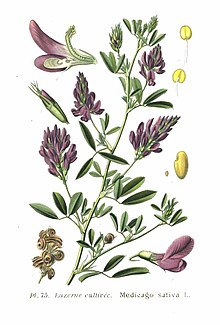Medicago sativa
| Alfalfa | |
|---|---|
 |
|
| Medicago sativa | |
| Scientific classification | |
| Kingdom: | Plantae |
| (unranked): | Angiosperms |
| (unranked): | Eudicots |
| (unranked): | Rosids |
| Order: | Fabales |
| Family: | Fabaceae |
| Genus: | Medicago |
| Species: | M. sativa |
| Binomial name | |
|
Medicago sativa L. |
|
| Subspecies | |
| Synonyms | |
|
List
|
|
| Nutritional value per 100 g (3.5 oz) | |
|---|---|
| Energy | 96 kJ (23 kcal) |
|
2.1 g
|
|
| Dietary fiber | 1.9 g |
|
0.7 g
|
|
|
4 g
|
|
| Vitamins | |
| Thiamine (B1) |
(7%)
0.076 mg |
| Riboflavin (B2) |
(11%)
0.126 mg |
| Niacin (B3) |
(3%)
0.481 mg |
| Pantothenic acid (B5) |
(11%)
0.563 mg |
| Vitamin B6 |
(3%)
0.034 mg |
| Folate (B9) |
(9%)
36 μg |
| Vitamin C |
(10%)
8.2 mg |
| Vitamin K |
(29%)
30.5 μg |
| Minerals | |
| Calcium |
(3%)
32 mg |
| Iron |
(7%)
0.96 mg |
| Magnesium |
(8%)
27 mg |
| Manganese |
(9%)
0.188 mg |
| Phosphorus |
(10%)
70 mg |
| Potassium |
(2%)
79 mg |
| Sodium |
(0%)
6 mg |
| Zinc |
(10%)
0.92 mg |
|
|
|
|
|
| Percentages are roughly approximated using US recommendations for adults. Source: USDA Nutrient Database |
|
Alfalfa /ælˈfælfə/, Medicago sativa also called lucerne, is a perennial flowering plant in the pea family Fabaceae cultivated as an important forage crop in many countries around the world. It is used for grazing, hay, and silage, as well as a green manure and cover crop. The name alfalfa is used in North America. The name lucerne is the more commonly used name in the United Kingdom, South Africa, Australia, and New Zealand. The plant superficially resembles clover (a cousin in the same family), especially while young, when trifoliate leaves comprising round leaflets predominate. Later in maturity, leaflets are elongated. It has clusters of small purple flowers followed by fruits spiralled in 2 to 3 turns containing 10–20 seeds. Alfalfa is native to warmer temperate climates. It has been cultivated as fodder since at least the era of the ancient Greeks and Romans. Alfalfa sprouts are a common ingredient in dishes made in South Indian cuisine.
Alfalfa seems to have originated in south-central Asia, and was first cultivated in ancient Iran. According to Pliny (died 79 AD), it was introduced to Greece in about 490 BC when the Persians invaded Greek territory. Alfalfa cultivation is discussed in the fourth-century AD book Opus Agriculturae by Palladius, stating: "One sow-down lasts ten years. The crop may be cut four or six times a year ... A jugerum of it is abundantly sufficient for three horses all the year ... It may be given to cattle, but new provender is at first to be administered very sparingly, because it bloats up the cattle." Pliny and Palladius called alfalfa in Latin medica, a name that referred to the Medes, a people who lived in ancient Iran. The ancient Greeks and Romans believed, probably correctly, that alfalfa came from the Medes' land, in today's Iran. (The ancient Greeks and Romans also used the name medica to mean a citron fruit, once again because it was believed to have come from the Medes' land). This name is the root of the modern scientific name for the alfalfa genus, Medicago.
...
Wikipedia
